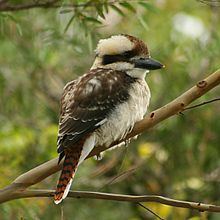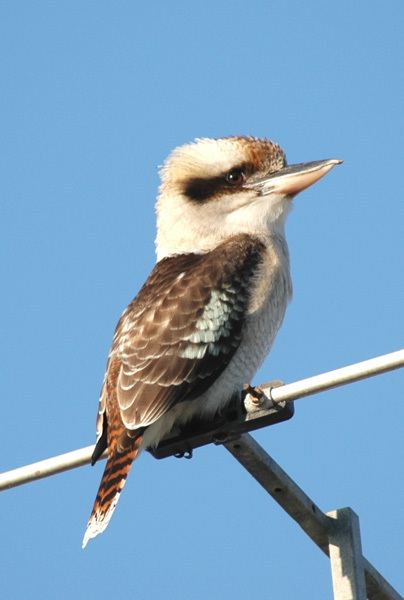Subfamily Halcyoninae Scientific name Dacelo novaeguineae Rank Species | Phylum Chordata Family Alcedinidae Genus Dacelo Symbol of New South Wales | |
 | ||
Similar Kookaburra, Bird, Kingfisher, Turaco, Common kingfisher | ||
Laughing kookaburra
The laughing kookaburra (Dacelo novaeguineae) is a bird in the kingfisher subfamily Halcyoninae. It is a large robust kingfisher with a whitish head and a dark eye-stripe. The upperparts are mostly dark brown but there is a mottled light-blue patch on the wing coverts. The underparts are white and the tail is barred with rufous and black. The plumage of the male and female birds is similar. The territorial call is a distinctive laugh that is often delivered by several birds at the same time.
Contents
- Laughing kookaburra
- Taxonomy
- Description
- Call
- Distribution and habitat
- Behaviour
- Breeding
- Feeding
- Status
- Interaction with humans
- References
The laughing kookaburra is native to eastern mainland Australia, but has also been introduced to parts of New Zealand, Tasmania, and Western Australia. It occupies dry eucalypt forest, woodland, city parks and gardens. This species is sedentary and occupies the same territory throughout the year. It is monogamous and retains the same partner for life. A breeding pair can be accompanied by up to five fully grown non-breeding offspring from previous years that help the parents defend their territory and raise their young. The laughing kookaburra generally breeds in unlined tree holes or in excavated holes in arboreal termite nests. The usual clutch is three white eggs. The parents and the helpers incubate the eggs and feed the chicks. The youngest of the three nestlings is often killed by the older siblings. When the chicks fledge they continue to be fed by the group for six to ten weeks until they are able to forage independently.

A predator of a wide variety of small animals, the laughing kookaburra typically waits perched on a branch until it sees an animal on the ground and then flies down and pounces on its prey. Its diet includes lizards, insects, worms and snakes.

The laughing kookaburra has a huge range and large population, with no widespread threats, so it is classed as a species of least concern by the International Union for Conservation of Nature (IUCN)."

Laughing kookaburra
Taxonomy
The laughing kookaburra was first described and illustrated (in black and white) by the French naturalist and explorer Pierre Sonnerat in his Voyage à la nouvelle Guinée which was published in 1776. He claimed to have seen the bird in New Guinea. In fact Sonnerat never visited New Guinea and the laughing kookaburra does not occur there. He probably obtained a preserved specimen from one of the naturalists who accompanied Captain James Cook to the east coast of Australia. Edme-Louis Daubenton and François-Nicolas Martinet included a coloured plate of the laughing kookaburra based on Sonnerat's specimen in their Planches enluminées d'histoire naturelle. The plate has the legend in French "Martin-pecheur, de la Nouvelle Guinée" (Kingfisher from New Guinea).

In 1783 the French naturalist Johann Hermann provided a formal description of the species based the coloured plate by Daubenton and Martinet. He gave it the scientific name Alcedo novæ Guineæ. The current genus Dacelo was introduced in 1815 by the English zoologist William Elford Leach, and is an anagram of Alcedo, the Latin word for a kingfisher. The specific name novaeguineae combines the Latin novus for new with Guinea, based on the erroneous belief that the specimen had originated from New Guinea. For many years it was believed that the earliest description was by the Dutch naturalist Pieter Boddaert and his scientific name Dacelo gigas was used in the scientific literature but in 1926 the Australian ornithologist Gregory Mathews showed that a description by Hermann had been published earlier in the same year, 1783, and thus had precedence.
In the 19th century this species was commonly called the "laughing jackass", a name first recorded (as Laughing Jack-Ass) in An Account of the English Colony in New South Wales by David Collins which was published in 1798. In 1858 the ornithologist John Gould used "great brown kingfisher", a name that had been coined by John Latham in 1782. Another popular name was "laughing kingfisher". The name in several Australian indigenous languages were listed by European authors including Go-gan-ne-gine by Collins in 1878, Cuck'anda by René Lesson in 1828 and Gogera or Gogobera by George Bennett in 1834. In the early years of the 20th century "kookaburra" was included as an alternative name in ornithological publications but it was not until 1926 in the second edition of the Official Checklist of Birds of Australia that the Royal Australasian Ornithologists Union officially adopted the name "laughing kookaburra". The name comes from Wiradhuri, an Aboriginal language now effectively extinct.
The genus Dacelo contains four kookaburra species of which the rufous-bellied kookaburra and the spangled kookaburra are restricted to New Guinea and islands in the Torres Straits. The blue-winged kookaburra and the laughing kookaburra are both widespread in Australia.
Two subspecies are recognised:
Description
The laughing kookaburra is the largest kingfisher. It is a stout, stocky bird 39–42 cm (15–17 in) in length, with a large head, prominent brown eyes, and a very large bill. The sexes are very similar, although the female is usually larger and has less blue to the rump than the male. The male weighs 310–345 g (10.9–12.2 oz) and the female 355–480 g (12.5–16.9 oz). They have a white or cream-coloured body and head with a dark brown stripe across each eye and more faintly over the top of the head. The wings and back are brown with sky blue spots on the shoulders. The tail is rusty reddish-orange with dark brown bars and white tips on the feathers. The heavy bill is black on top and bone-coloured on the bottom. The subspecies D. n. minor has a similar plumage to the nominate but is smaller in size.
Call
The name "laughing kookaburra" refers to the bird's "laugh", which it uses to establish territory among family groups. It can be heard at any time of day, but most frequently at dawn and dusk.
One bird starts with a low, hiccuping chuckle, then throws its head back in raucous laughter: often several others join in. If a rival tribe is within earshot and replies, the whole family soon gathers to fill the bush with ringing laughter. Hearing kookaburras in full voice is one of the more extraordinary experiences of the Australian bush, something even locals cannot ignore; some visitors, unless forewarned, may find their calls startling.
Distribution and habitat
The laughing kookaburra is native to eastern Australia and has a range that extends from the Cape York Peninsula in the north to Cape Otway in the south. It is present on both the eastern and the western sides of the Great Dividing Range. In the south the range extends westwards from Victoria to the Yorke Peninsula and the Flinders Ranges in South Australia.
It has been introduced into many other areas probably because of its reputation for killing snakes. In Western Australia, laughing kookaburras were released near Mullewa in around 1896 and over the following decade hundreds of birds were imported from Victoria and released around Perth. By 1912 breeding populations had been established in a number of areas. The present range in Western Australia is southwest of a line joining Geraldton on the west coast and Hopetoun on the south coast. In Tasmania the laughing kookaburra was introduced at several locations beginning in 1906. It now mainly occurs northeast of a line joining Huonville, Lake Rowallan, Watatah and Marrawah. It was introduced on Flinders Island in around 1940 where it is now widespread and on Kangaroo Island in 1926.
In the 1860's, during his second term as governor of New Zealand, George Grey arranged for the release of laughing kookaburras on Kawau Island. The island lies in the Hauraki Gulf, about 40 km (25 mi) north of Aukland on the North Island of New Zealand. It was thought that the introduction had been unsuccessful but in 1916 some birds were discovered on the adjacent mainland. It now breeds in a small region on the western side of the Hauraki Gulf between Leigh and Kumeu.
The usual habitat is open sclerophyll forest and woodland. It is more common where the understory is open and sparse or where the ground is covered with grass. Tree-holes are needed for nesting. It also occurs near wetlands and in partly cleared areas or farmland with trees along roads and fences. In urban areas it is found in parks and gardens. The range of the laughing kookaburra overlaps with that of the blue-winged kookaburra in an area of eastern Queensland that extends from the Cape York Peninsula south to near Brisbane. Around Cooktown the laughing kookaburra tends to favour areas near water while the blue-winged kookaburra keeps to drier habitats.
Behaviour
Kookaburras occupy woodland territories (including forests) in loose family groups, and their laughter serves the same purpose as a great many other bird calls—to mark territorial borders. Most species of kookaburras tend to live in family units, with offspring helping the parents hunt and care for the next generation of offspring.
Breeding
During mating season, the laughing kookaburra reputedly indulges in behaviour similar to that of a wattlebird. The female adopts a begging posture and vocalises like a young bird. The male then offers her his current catch accompanied with an "oo oo oo" sound. However, some observers maintain that the opposite happens - the female approaches the male with her current catch and offers it to him. Either way, they start breeding around October/November. If the first clutch fails, they will continue breeding into the summer months.
They generally lay three eggs at about two-day intervals. If the food supply is not adequate, the third egg will be smaller and the third chick will also be smaller and at a disadvantage relative to its larger siblings. Chicks have a hook on the upper mandible, which disappears by the time of fledging. If the food supply to the chicks is not adequate, the chicks will quarrel, with the hook being used as a weapon. The smallest chick may even be killed by its larger siblings. If food is plentiful, the parent birds spend more time brooding the chicks, so the chicks are not able to fight.
Feeding
Kookaburras hunt much as other kingfishers (or indeed Australasian robins) do, by perching on a convenient branch or wire and waiting patiently for prey to pass by. Common prey include mice and similar-sized small mammals, large insects, lizards, small birds and nestlings, and most famously, snakes. Small prey are preferred, but kookaburras sometimes take large creatures, including venomous snakes, much longer than their bodies.
Status
The population density of the laughing kookaburra in Australia varies between 0·04 and 0·8 birds/ha depending on the habitat. Assuming an average of 0.3 birds/ha the total population may be as large as 65 million individuals. The population in New Zealand is relatively small and is probably less than 500 individuals. Given the extended range and the large stable population, the species is evaluated as of "least concern" by the International Union for Conservation of Nature.
Interaction with humans
Laughing kookaburras are a common sight in suburban gardens and urban settings, even in built-up areas, and are so accustomed to humans that they will often eat out of their hands. It is not uncommon for kookaburras to snatch food out of people's hands without warning, by swooping in from a distance. People often feed them pieces of raw meat.
The kookaburra is also the subject of a popular Australian children's song, the "Kookaburra" which was written by Marion Sinclair in 1934.
